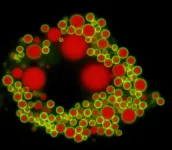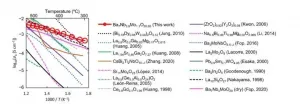Epilepsy research focused on astrocytes
Neurobiology: Publication in the Journal of the Society for Neuroscience
2021-01-25
(Press-News.org) During epileptic seizures, a large number of nerve cells in the brain fire excessively and in synchrony. This hyperactivity may lead to uncontrolled shaking of the body and involve periods of loss of consciousness. While about two thirds of patients respond to anti-epileptic medication, the remainder is refractory to medical treatment and shows drug-resistance. These patients are in urgent need for new therapeutic strategies.
Together with colleagues in Japan, Prof. Dr. Christine Rose and her doctoral student Jan Meyer from the Institute of Neurobiology at HHU have performed a study to address the cellular mechanisms that promote the development of epilepsy. While up to now, most studies and anti-epileptic drugs targeted nerve cells (neurons), this research team focused on a class of glial cells known as astrocytes.
Glial cells account for approximately half of all cells in the brain. There are different types of glial cells, which perform different functions. Astrocytes control the local environment and are responsible for the ion balance in the brain, but also play an important role in signal transmission between neurons.
In their recent paper, the researchers show that epileptic discharges lead to a rise in the pH of astrocytes, that is in their intracellular 'alkalisation'. The change in pH disrupts the communication within the intercellular astrocyte networks. This reduced communication between astrocytes appears to exacerbate epileptic activity of neurons.
This finding points towards a potential new target for suppressing epileptogenesis at a very early stage, namely by using drugs to suppress changes in astrocytic pH accompanying neuronal activity.
The researchers were able to confirm this option by showing that animals which were given such drugs suffered less severely from epileptic hyperexcitability than untreated animals.
Prof. Rose said: "This observation is very intriguing. But it still needs to be established whether or not it can be transferred to humans. And it will take a very long time before any potential drug can be developed and be really used in the clinics."
INFORMATION:
The research was carried out as a collaboration between the HHU and three universities in Japan (Keio University and Tokyo Medical and Dental University in Tokyo, Tohoku University in Sendai) as part of the "Young Glia" programme of the DFG-Priority Programme SPP 1757 "Functional Specialisations of Neuroglia" coordinated by Prof. Rose. This programme promotes collaboration between German and Japanese laboratories. In particular, it encourages and assists young scientists in realising their own bi-national research projects. For example, the HHU doctoral student Jan Meyer travelled to Japan, while Mariko Onodera from Tohoku University spent two periods working at the Institute of Neurobiology in Düsseldorf.
Original publication
Mariko Onodera, Jan Meyer, Kota Furukawa, Yuichi Hiraoka, Tomomi Aida, Kohichi Tanaka, Kenji F. Tanaka, Christine R. Rose, and Ko Matsui, Exacerbation of epilepsy by astrocyte alkalization and gap junction uncoupling, Journal of Neuroscience, 2021
DOI: 10.1523/JNEUROSCI.2365-20.2020
[Attachments] See images for this press release:

ELSE PRESS RELEASES FROM THIS DATE:
2021-01-25
Findings of a new study published by researchers from Trinity College Dublin and St James's Hospital outline the health impacts faced by older people while cocooning during the Covid-19 pandemic. The findings are published in the Quarterly Journal of Medicine here: https://bit.ly/3qGKJoI.
Cocooning involves staying at home and reducing face-to-face interaction with other people and is an important part of the response to the COVID-19 pandemic, with an overall aim to prevent transmission to vulnerable older people. However, concerns exist regarding the long-term adverse effects ...
2021-01-25
A new study from Indiana University researchers finds that most high-school age youth are willing to wear masks to help prevent the spread of the COVID-19 virus, but that more education is needed on how to wear masks properly and on the importance of consistent commitment to public health guidelines.
The study, published today in the Journal of Adolescent Health looked at 1,152 youth's mask wearing and social distancing behaviors during five, in-person live-streamed high school graduations from one U.S. public school district in early July 2020. These broadcasts allowed the researchers to systematically document social-distancing behaviors throughout the ceremonies and mask-wearing as students crossed the graduation stage ...
2021-01-25
Coconut oil has increasingly found its way into German kitchens in recent years, although its alleged health benefits are controversial. Scientists at the University of Bonn have now been able to show how it is metabolized in the liver. Their findings could also have implications for the treatment of certain diarrheal diseases. The results are published in the journal Molecular Metabolism.
Coconut oil differs from rapeseed or olive oil in the fatty acids it contains. Fatty acids consist of carbon atoms bonded together, usually 18 in number. In coconut oil, however, most of these chains are much shorter and contain only ...
2021-01-25
Research from North Carolina State University shows that extreme weather events, such as hurricanes and increased precipitation, affect both the amount and the composition of picophytoplankton in the Neuse River Estuary. The work is a first step in determining how a wetter climate may affect the estuarine ecosystem.
Picophytoplankton are defined as any phytoplankton measuring less than three micrometers in size. Although well studied as part of the oceanic ecosystem and food web, picophytoplankton are understudied in estuarine systems, even though they occur in significant numbers within these environments.
"Picophytoplankton are important primary producers in aquatic ecosystems," says Ryan Paerl, assistant professor of ...
2021-01-25
DALLAS - Jan. 25, 2021 - Small cell lung cancer (SCLC) cells are missing a surface protein that triggers an immune response, allowing them to hide from one of the body's key cancer defenses, a new study led by UT Southwestern researchers suggests. The findings, reported online today in Cancer Research, a journal of the American Association for Cancer Research, could lead to new treatments for SCLC, which has no effective therapies.
Despite decades of study, SCLC - a subset of lung cancer that makes up about 13 percent of lung cancer diagnoses - has a very poor prognosis, with only about 6 percent of patients surviving five years after ...
2021-01-25
Massive earthquakes are, fortunately, rare events. But that scarcity of information blinds us in some ways to their risks, especially when it comes to determining the risk for a specific location or structure.
"We haven't observed most of the possible events that could cause large damage," explained Kevin Milner, a computer scientist and seismology researcher at the Southern California Earthquake Center (SCEC) at the University of Southern California. "Using Southern California as an example, we haven't had a truly big earthquake since 1857 -- that was the last time the southern San Andreas broke into a massive magnitude ...
2021-01-25
Scientists at Tokyo Institute of Technology (Tokyo Tech), Imperial and High Energy Accelerator Research Organization (KEK) Institute of Materials Structure Science, discover new Ba7Nb4MoO20-based materials with high oxygen-ion (oxide-ion O2-) conductivities--"the hexagonal perovskite-related oxides"--and shed light on the underlying mechanisms responsible for their conductivity. Their findings lead the way to uncovering other similar materials, furthering research on developing low-cost and scalable renewable energy technologies.
Over the past few years, fuel cells have become a focal point of research in eco-friendly technology because of their ...
2021-01-25
Researchers from the Max Born Institute for Nonlinear Optics and Short Pulse Spectroscopy (MBI) have developed a new method to modify the spectral width of extreme-ultraviolet (XUV) light. By employing a novel phase-matching scheme in four-wave mixing, they could compress the spectral width of the initial broadband light by more than hundred times. The detailed experimental and theoretical results have been published in Nature Photonics.
Light, as emitted by the sun, consists of many different colors and typically appears as white. Sometimes, however, only certain colors reach our eyes, leading to stunning phenomena like an afterglow. For technical or scientific applications that require a specific color, gratings and prisms can be used to extract this color ...
2021-01-25
What The Study Did: The results of this study suggest that cumulative exposure to cigarette smoke is an independent risk factor for hospital admission and death from COVID-19.
Authors: Katherine E. Lowe, M.Sc., of the Cleveland Clinic Lerner College of Medicine of Case Western Reserve in Cleveland, is the corresponding author.
To access the embargoed study: Visit our For The Media website at this link https://media.jamanetwork.com/
(doi:10.1001/jamainternmed.2020.8360)
Editor's Note: The article includes conflicts of interest and funding/support disclosures. Please see the article for ...
2021-01-25
What The Study Did: The association of a shelter-in-place order with lower rates of seasonal respiratory viral activity was examined in this study.
Authors: Elizabeth Partridge, M.D., of the University of California at Davis School of Medicine in Sacramento, is the corresponding author.
To access the embargoed study: Visit our For The Media website at this link https://media.jamanetwork.com/
(doi:10.1001/jamanetworkopen.2020.35281)
Editor's Note: The article includes conflict of interest and funding/support disclosures. Please see the article for additional information, including other authors, author contributions and affiliations, conflict of interest and financial disclosures, and funding and support.
INFORMATION:
Media ...
LAST 30 PRESS RELEASES:
[Press-News.org] Epilepsy research focused on astrocytes
Neurobiology: Publication in the Journal of the Society for Neuroscience






